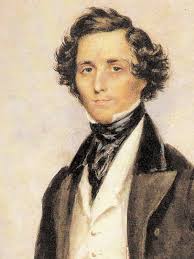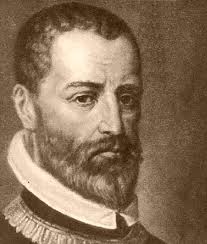February 2, 2015.Mendelssohn and Palestrina.Felix Mendelssohn was born on February 3rd, 1809 in Hamburg into an eminent Jewish family.We had explored his family history and childhood years in our previous posts.Mendelssohn continues to be widely performed, especially his ever-popular Violin concerto, the symphonies and the music for A Midsummer Night's Dream.His Songs Without Words for the piano also used to be performed often, but lately they pretty much disappeared from the concert repertoire.It’s a pity, as some of them are absolute gems.Mendelssohn wrote eight volumes (or books) of Songs, each consisting of just six songs.The first book was written in 1829-1830, and the first songs were written for the album of Felix’s beloved sister Fanny; the last one – in1842-1845, shortly before Mendelssohn’s premature death at the age of 38.Here are two Songs, both bearing subtitles (only few pieces have them): from Book 2, op. 30, no. 6, Allegretto tranquillo in F-sharp minor ("Venezianisches Gondellied" or Song of the Venetian gondolier), here, and the Spring song, from Book 5, Op. 62, also no. 6 (here).Both are performed by Daniel Barenboim; the recording was made in 1973.
The music of Giovanni Pierluigi da Palestrina represents a pinnacle of the Renaissance.After about 150 years of development, starting with Guillaume Dufay, the music, the first truly “classical” one in our modern understanding, had reach unprecedented levels of individuality and sophistication.Palestrina, Orlando di Lasso, and their younger contemporaries Tomás Luis de Victoria and William Byrd – the Italian, the Fleming, the Spaniard and the English – perfected polyphony and thus influenced generations of composers, from Bach to composers of the 20th century.Palestrina, the oldest of the four, was born around this date in 1525 (as is so often the case with Renaissance composers, the real date is in dispute).He spent most of his life in Rome.The Pope Julius III recognized his talent and appointed Palestrina maestro di cappella of the Capella Giulia, the official choir of Saint Peter’s basilica.Later, Palestrina held similar positions in several other churches, including San Giovanni di Laterano, where Orlando served some years earlier, and Santa Maria Maggiore.
Palestrina, who composed most of his life, left a treasure trove of music: more than 100 masses, hundreds of madrigals and motets.He wrote Missa Brevis, a shorter mass, around 1570; at that time his was employed at the Santa Maria Maggiore, and his fame was spreading around Europe.By then he had received an offer from the Holy Roman Emperor Maximilan II (they ended up being unable to work out the terms) and was in an epistolary exchange with Guglielmo Gonzaga, the Duke of Mantua – they were discussing musical matters.Here’s the first part of the mass, Kyrie; it’s performed by The Tallis Scholars.Two years later he wrote a motet Tu Es Petrus.By then he had returned to the Saint Peter’s basilica and again was put in charge of the Capella Giulia. You can hear it in the performance by the choir of Westminster Abbey.Almost twenty years later, in 1591, Palestrina wrote several settings of Magnificat (the song of the Blessed Virgin Mary).Here’s one of them, Magnificat primi toni, performed by the English ensemble Voces8.
Mendelssohn and Palestrina, 2015
February 2, 2015. Mendelssohn and Palestrina. Felix Mendelssohn was born on February 3rd, 1809 in Hamburg into an eminent Jewish family. We had explored his family history and childhood years in our previous posts. Mendelssohn continues to be widely performed, especially his ever-popular Violin concerto, the symphonies and the music for A Midsummer Night's Dream. His Songs Without Words for the piano also used to be performed often, but lately they pretty much disappeared from the concert repertoire. It’s a pity, as some of them are absolute gems. Mendelssohn wrote eight volumes (or books) of Songs, each consisting of just six songs. The first book was written in 1829-1830, and the first songs were written for the album of Felix’s beloved sister Fanny; the last one – in1842-1845, shortly before Mendelssohn’s premature death at the age of 38. Here are two Songs, both bearing subtitles (only few pieces have them): from Book 2, op. 30, no. 6, Allegretto tranquillo in F-sharp minor ("Venezianisches Gondellied" or Song of the Venetian gondolier), here, and the Spring song, from Book 5, Op. 62, also no. 6 (here). Both are performed by Daniel Barenboim; the recording was made in 1973.
Violin concerto, the symphonies and the music for A Midsummer Night's Dream. His Songs Without Words for the piano also used to be performed often, but lately they pretty much disappeared from the concert repertoire. It’s a pity, as some of them are absolute gems. Mendelssohn wrote eight volumes (or books) of Songs, each consisting of just six songs. The first book was written in 1829-1830, and the first songs were written for the album of Felix’s beloved sister Fanny; the last one – in1842-1845, shortly before Mendelssohn’s premature death at the age of 38. Here are two Songs, both bearing subtitles (only few pieces have them): from Book 2, op. 30, no. 6, Allegretto tranquillo in F-sharp minor ("Venezianisches Gondellied" or Song of the Venetian gondolier), here, and the Spring song, from Book 5, Op. 62, also no. 6 (here). Both are performed by Daniel Barenboim; the recording was made in 1973.
The music of Giovanni Pierluigi da Palestrina represents a pinnacle of the Renaissance. After about 150 years of development, starting with Guillaume Dufay, the music, the first truly “classical” one in our modern understanding, had reach unprecedented levels of individuality and sophistication. Palestrina, Orlando di Lasso, and their younger contemporaries Tomás Luis de Victoria and William Byrd – the Italian, the Fleming, the Spaniard and the English – perfected polyphony and thus influenced generations of composers, from Bach to composers of the 20th century. Palestrina, the oldest of the four, was born around this date in 1525 (as is so often the case with Renaissance composers, the real date is in dispute). He spent most of his life in Rome. The Pope Julius III recognized his talent and appointed Palestrina maestro di cappella of the Capella Giulia, the official choir of Saint Peter’s basilica. Later, Palestrina held similar positions in several other churches, including San Giovanni di Laterano, where Orlando served some years earlier, and Santa Maria Maggiore.
basilica. Later, Palestrina held similar positions in several other churches, including San Giovanni di Laterano, where Orlando served some years earlier, and Santa Maria Maggiore.
Palestrina, who composed most of his life, left a treasure trove of music: more than 100 masses, hundreds of madrigals and motets. He wrote Missa Brevis, a shorter mass, around 1570; at that time his was employed at the Santa Maria Maggiore, and his fame was spreading around Europe. By then he had received an offer from the Holy Roman Emperor Maximilan II (they ended up being unable to work out the terms) and was in an epistolary exchange with Guglielmo Gonzaga, the Duke of Mantua – they were discussing musical matters. Here’s the first part of the mass, Kyrie; it’s performed by The Tallis Scholars. Two years later he wrote a motet Tu Es Petrus. By then he had returned to the Saint Peter’s basilica and again was put in charge of the Capella Giulia. You can hear it in the performance by the choir of Westminster Abbey. Almost twenty years later, in 1591, Palestrina wrote several settings of Magnificat (the song of the Blessed Virgin Mary). Here’s one of them, Magnificat primi toni, performed by the English ensemble Voces8.